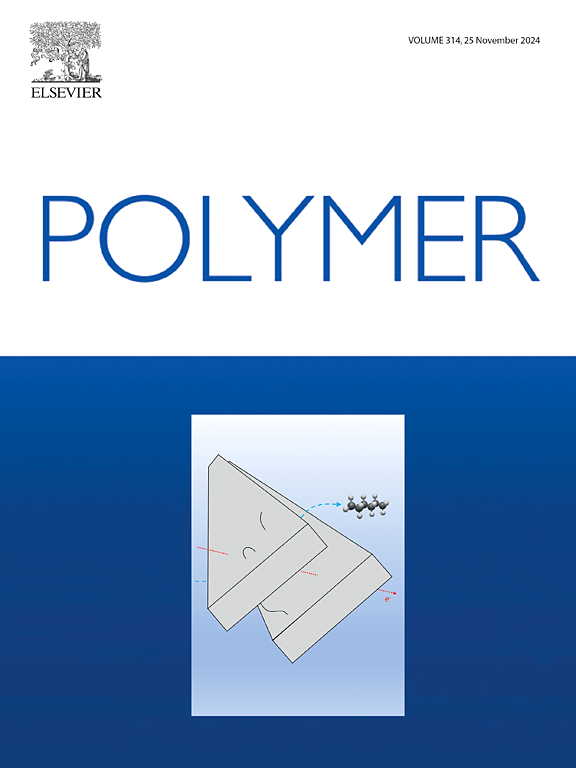Controlled stiffness and diffusivity of poly(ethylene glycol) hydrogel formed with cellulose-nanofiber framework
IF 4.1
2区 化学
Q2 POLYMER SCIENCE
引用次数: 0
Abstract
Hydrogels composed of polymer networks are widely used in industry and scientific research for high water retention and unique mechanical properties. Nevertheless, in ordinary hydrogel formation, the trade-off relationship between stiffness and mesh size remains a crucial consideration for practical applications. This study describes a facile approach to controlling hydrogel stiffness and mesh size by hybridizing poly (ethylene glycol) diacrylate (PEGDA) and methacrylated TEMPO-oxidized cellulose nanofibers (T-CNFMA). After disintegrating T-CNF by ultrasonication, T-CNFMA was synthesized resulting in a degree of substitution of 2.04 mmol/g. Incorporation of T-CNFMA in the PEGDA network allowed for independent control of hydrogel stiffness and mesh size by reinforcing the whole hydrogel network as a framework. Consequently, the swelling ratio and shear modulus could be manipulated by controlling the PEGDA/T-CNFMA ratio. Structural analyses revealed that an increase in the T-CNFMA content in the presence of a low amount of PEGDA resulted in a large mesh size with a constant stiffness. The diffusivity test was also consistent with the properties of the hydrogels. This result indicates that the incorporation of T-CNF in hydrogel network is useful to control the physical property of the hydrogel, especially for varying mesh size, regardless of stiffness alteration.


纤维素-纳米纤维框架形成的聚乙二醇水凝胶的可控刚度和扩散性
由聚合物网络组成的水凝胶因其高保水性和独特的机械特性而被广泛应用于工业和科学研究领域。然而,在普通水凝胶的形成过程中,刚度和网眼尺寸之间的权衡关系仍然是实际应用中的一个重要考虑因素。本研究介绍了一种通过杂交聚(乙二醇)二丙烯酸酯(PEGDA)和甲基丙烯酸 TEMPO 氧化纤维素纳米纤维(T-CNFMA)来控制水凝胶硬度和网眼尺寸的简便方法。用超声波分解 T-CNF 后,合成出取代度为 2.04 mmol/g 的 T-CNFMA。在 PEGDA 网络中加入 T-CNFMA 后,通过加强整个水凝胶网络的框架,可以独立控制水凝胶的硬度和网孔大小。因此,可以通过控制 PEGDA/T-CNFMA 的比例来调节膨胀率和剪切模量。结构分析表明,在 PEGDA 含量较低的情况下,增加 T-CNFMA 的含量可使网眼尺寸变大,刚度不变。扩散性测试也与水凝胶的特性一致。这一结果表明,在水凝胶网络中加入 T-CNF 有助于控制水凝胶的物理性质,尤其是在改变网眼尺寸时,而不受刚度变化的影响。
本文章由计算机程序翻译,如有差异,请以英文原文为准。
求助全文
约1分钟内获得全文
求助全文
来源期刊

Polymer
化学-高分子科学
CiteScore
7.90
自引率
8.70%
发文量
959
审稿时长
32 days
期刊介绍:
Polymer is an interdisciplinary journal dedicated to publishing innovative and significant advances in Polymer Physics, Chemistry and Technology. We welcome submissions on polymer hybrids, nanocomposites, characterisation and self-assembly. Polymer also publishes work on the technological application of polymers in energy and optoelectronics.
The main scope is covered but not limited to the following core areas:
Polymer Materials
Nanocomposites and hybrid nanomaterials
Polymer blends, films, fibres, networks and porous materials
Physical Characterization
Characterisation, modelling and simulation* of molecular and materials properties in bulk, solution, and thin films
Polymer Engineering
Advanced multiscale processing methods
Polymer Synthesis, Modification and Self-assembly
Including designer polymer architectures, mechanisms and kinetics, and supramolecular polymerization
Technological Applications
Polymers for energy generation and storage
Polymer membranes for separation technology
Polymers for opto- and microelectronics.
 求助内容:
求助内容: 应助结果提醒方式:
应助结果提醒方式:


